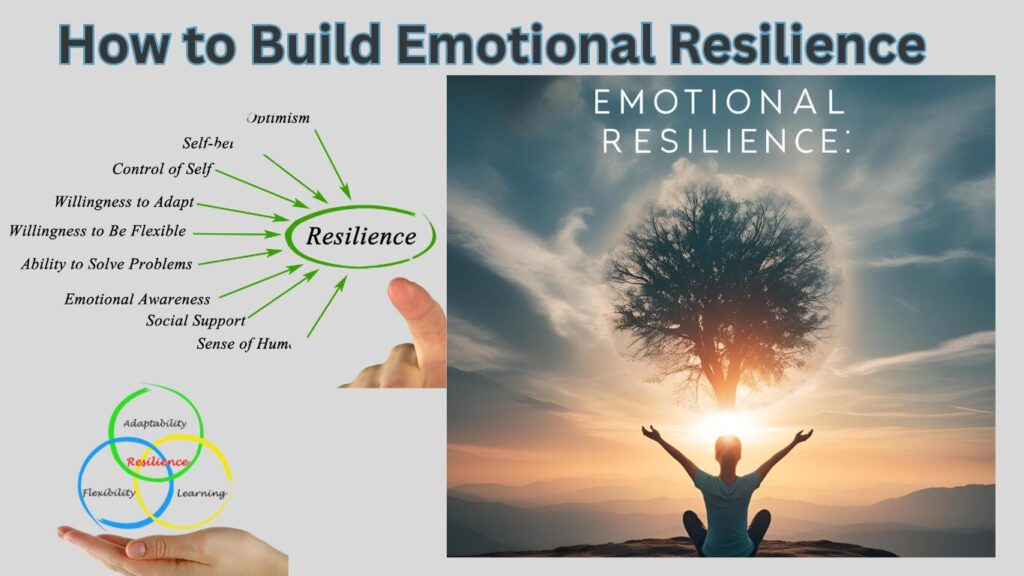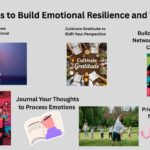How to Build Emotional Resilience: A Step-by-Step Guide to Thriving Through Life’s Challenges
Introduction: Why Emotional Resilience Matters More Than Ever
How-to-Build-Emotional-Resilience
In today’s fast-paced world, where stress and uncertainty are constant companions, emotional resilience has become vital for navigating life’s ups and downs. But what exactly is emotional resilience? Simply put, it’s the ability to adapt, recover, and grow more decisive when faced with adversity, setbacks, or stress. Whether you’re dealing with work pressure, relationship struggles, or personal challenges, building emotional resilience can help you stay grounded and focused.
This guide will walk you through the science-backed strategies to develop emotional resilience, offering actionable steps to incorporate into your daily routine. By the end of this article, you’ll have a clear roadmap to survive and thrive in the face of life’s challenges.
What is Emotional Resilience?
Emotional resilience refers to your capacity to handle difficult emotions, bounce back from setbacks, and maintain a positive outlook despite adversity. It’s not about avoiding pain or hardship but learning how to respond to these experiences healthily and constructively.
5 Daily Habits to Build Emotional Resilience.
Building emotional resilience doesn’t require drastic changes. Small, consistent habits can
make a significant difference. Here are five daily practices to get started:
1. Practice Mindfulness Meditation
Mindfulness meditation is one of the most effective ways to build emotional resilience.
By focusing on the present moment, you can reduce anxiety and improve your ability to
manage stress. Start with 5–10 minutes daily using guided meditation apps like
Headspace or Calm.
Pro Tip: Incorporate deep breathing exercises to calm your nervous system during
stressful moments. How-to-Build-Emotional-Resilience
2. Journal Your Thoughts and Feelings
Journaling is a powerful tool for processing emotions and gaining clarity.
Could you write about your daily experiences, challenges, and wins? This practice helps you
release pent-up emotions and fosters self-awareness—a key component of resilience.
by encouraging reflection and emotional processing.
3. Cultivate Gratitude
Gratitude shifts your focus from what’s wrong to what’s right in your life.
Each day, write down three things you’re grateful for.
Over time, this simple habit can rewire your brain to notice positivity more readily.
4. Prioritise Physical Health
Your mental and physical health are deeply interconnected. Regular exercise, a balanced diet,
and adequate sleep contribute to emotional resilience. Endorphins that boost mood,
5. Build a Supportive Network
Strong social connections are crucial for emotional resilience. Surround yourself with people who
uplift and inspire. Don’t hesitate to seek support when needed—asking for help is a sign of
strength, not weakness.
How to Bounce Back from Failure: A Resilience Guide
Failure is an inevitable part of life, but it doesn’t have to define you. Failure can be among the most
outstanding teachers if approached with the right mindset. Here’s how to use failure as a stepping stone
to greater resilience:
How to Build Emotional Resilience
Reframe Failure as Feedback
Instead of viewing failure as a reflection of your worth, see it as valuable feedback. Ask yourself:
What can I learn from this experience? This shift in perspective can help you grow rather
than dwell on mistakes.
Set Realistic Expectations
Perfectionism often leads to fear of failure. Setting realistic goals and embracing imperfection
can reduce the pressure to succeed at all costs.
Celebrate Small Wins
Acknowledge and celebrate your progress, no matter how small. This reinforces a
positive mindset and builds confidence in overcoming obstacles.
The Role of Self-Compassion in Building Resilience
Self-compassion is a cornerstone of emotional resilience. Unlike self-criticism, which erodes
confidence and increases stress; self-compassion involves treating yourself with kindness
and understanding during tough times.
- Self-kindness: Being gentle with yourself instead of harshly judgmental.
- Common humanity: Recognizing that suffering and failure are universal experiences.
- Mindfulness: Observing your thoughts and feelings without over-identifying with them
-
Overcoming Adversity: Stories of Emotional Resilience
-
Stories of resilience can inspire and motivate us to keep pushing forward.
-
J.K. Rowling faced numerous rejections before publishing the Harry Potter series.
-
Or Malala Yousafzai, who survived an assassination attempt and went on to become
-
a global advocate for girls’ education.
-
These stories remind us that resilience isn’t about avoiding hardship but persevering despite it. Reflect on your
-
own journey: What challenges have you overcome? How did they shape you into the person you are today?
-
Your Path to Greater Emotional Resilience Starts Today
-
Building emotional resilience is a lifelong journey, but the rewards are worthwhile. Incorporating mindfulness,
-
Gratitude and self-compassion in your daily routine allow you to develop the mental strength to thrive.
Remember, resilience isn’t about being immune to pain or hardship—it’s about finding the courage to move forward,
even when the path feels uncertain. Start small, stay consistent, and trust the process. You’ve got this!
Q&A: How to Build Emotional Resilience
1. What is emotional resilience, and why is it important?
A: Emotional resilience is the ability to adapt to stress, overcome adversity, and recover from challenges while maintaining mental well-being. It’s crucial because it empowers you to navigate life’s ups and downs without being overwhelmed, fostering long-term cognitive health, stronger relationships, and personal growth.
2. What’s the first step to building emotional resilience?
A: Start by cultivating self-awareness. Recognise your emotional triggers, thought patterns, and reactions to stress. Journaling or mindfulness practices can help you identify areas where you need to build resilience and track progress over time.
3. How can I reframe negative thoughts during challenging situations?
A: Practice cognitive restructuring: Challenge pessimistic thoughts by asking, “Is this true?” or “What’s another way to view this?” Replace catastrophising with balanced perspectives (e.g., “This is tough, but I can learn from it”). Over time, this rewires your brain to default to resilience.
4. Why is self-care critical for emotional resilience?
A: Self-care (sleep, nutrition, exercise) replenishes your physical and mental energy, creating a strong foundation to handle stress. Neglecting it leaves you vulnerable to burnout, making it harder to cope with challenges.
5. How do I build a support system to enhance resilience?
A: Nurture relationships with empathetic friends, family, or mentors. Be proactive in asking for help and offering support to others. Joining groups with shared interests or challenges (e.g., therapy, clubs) can also provide accountability and connection.
6. Can mindfulness help with resilience? How?
A: Yes! Mindfulness reduces stress by anchoring you in the present moment, preventing rumination about the past or anxiety about the future. Techniques like deep breathing or meditation help you respond calmly rather than react impulsively to stressors.
7. What’s a common mistake people make when building resilience?
A: Suppressing emotions or pretending everything is fine. Resilience isn’t about ignoring pain—it’s about acknowledging feelings, processing them healthily, and then taking constructive action.
8. How can I stay resilient during prolonged challenges (e.g., chronic illness or job loss)?
A: Break challenges into smaller, manageable goals. Focus on what you can control (e.g., daily routines, seeking resources) and celebrate small wins. Lean on your support system and remind yourself of past successes to boost confidence.
9. How do I know if I’m becoming more emotionally resilient?
A: Signs include bouncing back from setbacks faster, feeling less overwhelmed by stress, and approaching problems with curiosity rather than fear. You might also notice improved relationships and a stronger sense of purpose.
10. Can resilience be built at any age?
A: Absolutely! While habits formed early help, neuroplasticity allows the brain to adapt throughout life. Consistency in practicing resilience-building strategies (e.g., gratitude, problem-solving) fosters growth at any stage.
Bonus Q: How long does it take to see results?
A: It varies, but small changes can emerge in weeks. Long-term resilience develops through ongoing practice, like building a muscle. Celebrate progress, not perfection



.jpg)

